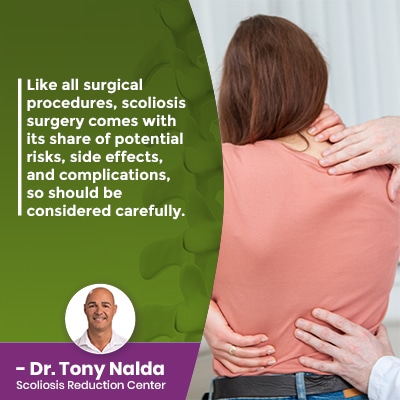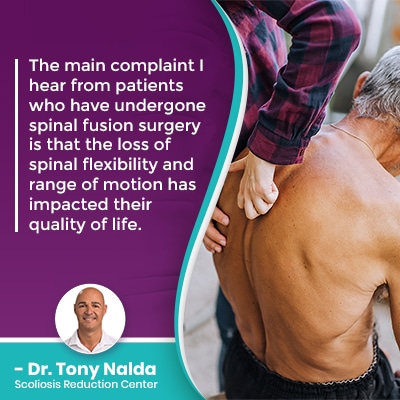When it comes to scoliosis treatment, understanding the options available is key because different types of treatment affect the spine differently, and when it comes to spinal fusion, we’re talking about a spine that’s not going to be as strong or flexible, and this can impact overall quality of life.
Scoliosis surgery is an invasive and costly surgical procedure that can affect the spine in different ways, not all positive. The reality is that not all cases of scoliosis require surgery, and knowing the right questions to ask can help ensure patients are making informed treatment choices.
There are two main scoliosis treatment approaches, traditional and conservative, the former offers a surgical response, and the latter offers a non-surgical treatment alternative.
Scoliosis Treatment Options: Traditional vs Conservative
Before moving on to 11 helpful questions to ask regarding scoliosis surgery, let’s first touch on the main difference between a surgical and non-surgical treatment response.
Scoliosis is a structural spinal condition that involves the development of an unnatural sideways spinal curve that also twists, and this makes it a 3-dimensional condition.
In addition, scoliosis is also progressive, meaning it has it in its nature to get worse over time, which is why how a diagnosis is responded to is so important; choosing one treatment over another can affect how a patient’s spine will function for the rest of their lives.
Traditional treatment offers a reactive response by focusing on watching and waiting while conditions are mild, while modern conservative treatment offers a proactive response by starting treatment as close to the time of diagnosis as possible.
Patients who are diagnosed with scoliosis and are trying to decide on which treatment approach to commit to should consider asking the following 11 scoliosis surgery questions:
1) What is Scoliosis Surgery?

Scoliosis surgery is a type of spinal fusion that involves fusing the curve’s most-tilted vertebrae, at its apex, into one solid bone, and rods are commonly attached to the spine with pedicle screws to hold it in place.
Like all surgical procedures, scoliosis surgery comes with its share of potential risks, side effects, and complications, so should be considered carefully.
2) Do All Cases of Scoliosis Require Surgical Treatment?
Traditional treatment funnels patients towards spinal fusion surgery because it doesn’t have a strategy for treating scoliosis while mild, so it does little to prevent progression, but when/if a condition has progressed into the severe classification, surgery is commonly recommended.
The reality, however, is that many cases of scoliosis can be treated without surgery, particularly those that are diagnosed while mild and are responded to with a proactive treatment plan as close to the time of diagnosis as possible.
3) What are Some Potential Risks Associated with the Surgery Itself?
When it comes to scoliosis surgery, there are both short- and long-term risks to be considered.
Short-term risks are those associated with the procedure itself: nerve damage, infection, excessive blood loss, and an adverse reaction to hardware used.
4) What are Some Potential Long-Term Risks of Scoliosis Surgery?
Each patient will respond to scoliosis surgery in their own way, and some important factors include patient age and overall health, condition type, severity, curvature location, and the number of vertebrae fused.
The more vertebrae are fused, the more invasive the procedure, and the more likely it is that some adverse effects will develop.
Some potential long-term side effects of scoliosis surgery include increased back pain around the fusion site and a loss in spinal flexibility and range of motion.
In addition, a fused spine is not as strong, so is more vulnerable to injury.
5) How is Scoliosis Treated Without Surgery?
Modern conservative scoliosis treatment offers a non-surgical treatment response, and this is what patients of the Scoliosis Reduction Center® benefit from.
Conservative treatment is also known as chiropractic-centered and/or functional treatment because it strives to address the scoliosis while preserving as much of the spine’s natural strength and function as possible.
Scoliosis is structural, so conservative treatment has the primary goal of achieving a curvature reduction on a structural level, and then physical therapy and scoliosis-specific exercises (SSEs) are introduced as a means of increasing core strength so the spine’s surrounding muscles can optimally support it.
Corrective bracing can help by pushing the spine into a corrective position, and rehabilitation involves a series of condition-specific exercises to further heal and stabilize the spine from home.
6) What Recourse is there if Spinal Fusion Fails?
The main goal of spinal fusion is to stop movement (progression) in the fused portion; the vertebrae can’t become more unnaturally tilted over time, but there is no guarantee that progression won’t continue.
In addition, there are other reasons spinal fusion can be unsuccessful, such as cases of hardware malfunction.
While not common, rods can crack, and screws can come loose, and if for any reason, spinal fusion is considered unsuccessful, the only recourse is more surgery; once a spine is fused, it’s fused for life.
It’s also important to understand that with each subsequent surgery, and as a patient ages, the risks increase.
7) What Recourse is there if Non-Surgical Treatment Fails?
Non-surgical treatment is non-invasive so doesn’t carry the serious potential risks, side effects, and complications of a surgical response.
If conservative treatment is unsuccessful at reducing a scoliotic curve, there is no harm done, results aren’t irreversible as they are with spinal fusion, and patients can continue to try and reduce their curve with natural conservative treatment, or they can opt for the more-invasive approach of scoliosis surgery.
8) What is the Monetary Cost of Spinal Fusion?
As mentioned earlier, there are a lot of variables that factor into how a patient responds to spinal fusion, and there are just as many variables that factor into the procedure’s final cost.
Some fluctuating factors can include individual surgeon fees, whether or not there were any complications during the procedure, the number of vertebrae fused, type and amount of hardware used, location of the fusion site, how long the surgery takes, and recovery time spent in hospital.
An average ballpark figure for the final monetary cost of spinal fusion surgery can fall within a range of $100,000 to $250,000, with most settling in at around $110,000.
9) Why Did My Family Doctor Refer Me Straight to an Orthopedic Surgeon?
As the most-prevalent form of scoliosis is adolescent idiopathic scoliosis, diagnosed between the ages of 10 and 18, let’s focus on this condition type.
Adolescents recently diagnosed by a family doctor are only receiving general medical care, not scoliosis-specific care; only a scoliosis specialist trained in the complexities of the condition and treatment efficacy can treat the condition itself, rather than focusing solely on addressing the condition’s symptoms.
A general practitioner would default to traditional surgical treatment because they are not a specialist aware of the different treatment options available, so this is where patients face a fork in the road on their scoliosis-journey: deciding how to treat it moving forward.
10) What’s it Like to Live with a Fused Spine?

The main complaint I hear from patients who have undergone spinal fusion surgery is that the loss of spinal flexibility and range of motion has impacted their quality of life.
In some cases, patients maintain enough flexibility above and below the fused portion to not experience a noticeable difference, but many do, and this can mean activity restrictions and/or not being able to participate in once-loved sports and activities.
In addition, the knowledge that one is living with a spine that’s weaker and more vulnerable to injury can have a psychological impact, commonly causing patients to become fearful of trying new things, and this type of effect shouldn’t be discounted.
11) How is Conservative Treatment Better for the Spine?
Conservative treatment is aligned with the spine’s natural design and function.
The spine’s design is movement-based, which is contrary to the concept of spinal fusion, and conservative treatment looks to improve the spine’s position through condition-specific chiropractic care, physical therapy, corrective bracing, and rehabilitation.
When multiple condition-specific treatment disciplines are integrated into a proactive treatment plan, conditions can be impacted on every level.
Conservative treatment is also proactive as it starts immediately following a diagnosis in the interest of preventing progression, increasing condition effects, and the need for invasive surgical treatment in the future.
Conservative treatment offers a more-natural way of reducing a scoliosis and isn’t known to weaken the spine or impact its flexibility and/or range of motion negatively.
Conclusion
Scoliosis surgery still has its place in scoliosis treatment, but what I want patients to be fully aware of is that surgery is not the only way to treat scoliosis.
I want patients to be fully aware of all treatment options available to them because different approaches offer different potential results, and as the spine is such an integral structure of human anatomy, its health can impact quality of life in a number of ways.
Spinal fusion is an invasive and costly procedure with some serious potential risks, so it should be considered carefully.
Here at the Center, I spend a lot of time discussing treatment options with my patients, and while there are never treatment guarantees, for those who choose to forgo a surgical recommendation, or who simply want to try a less-invasive treatment option first, conservative chiropractic-centered treatment has produced impressive results.




